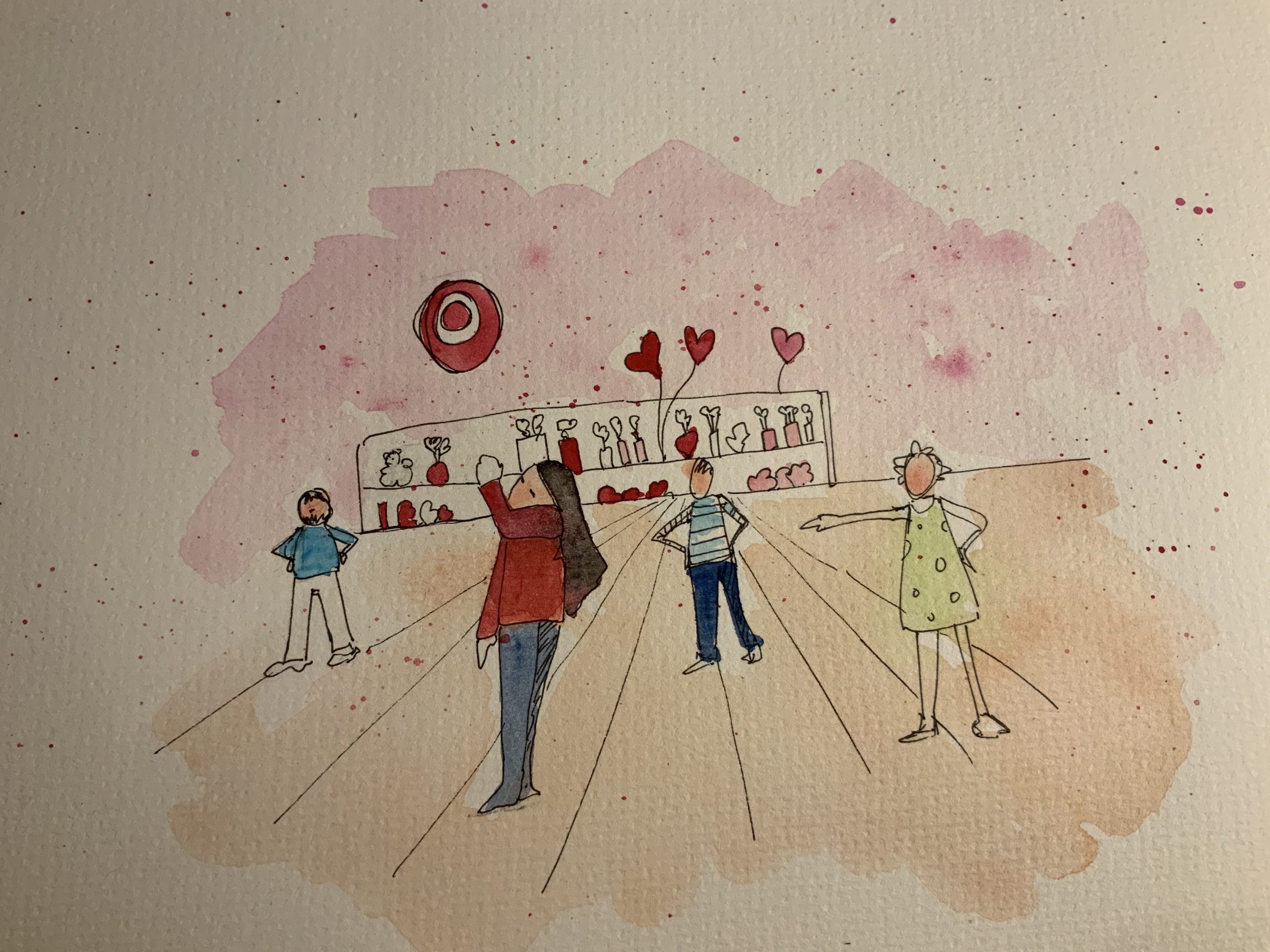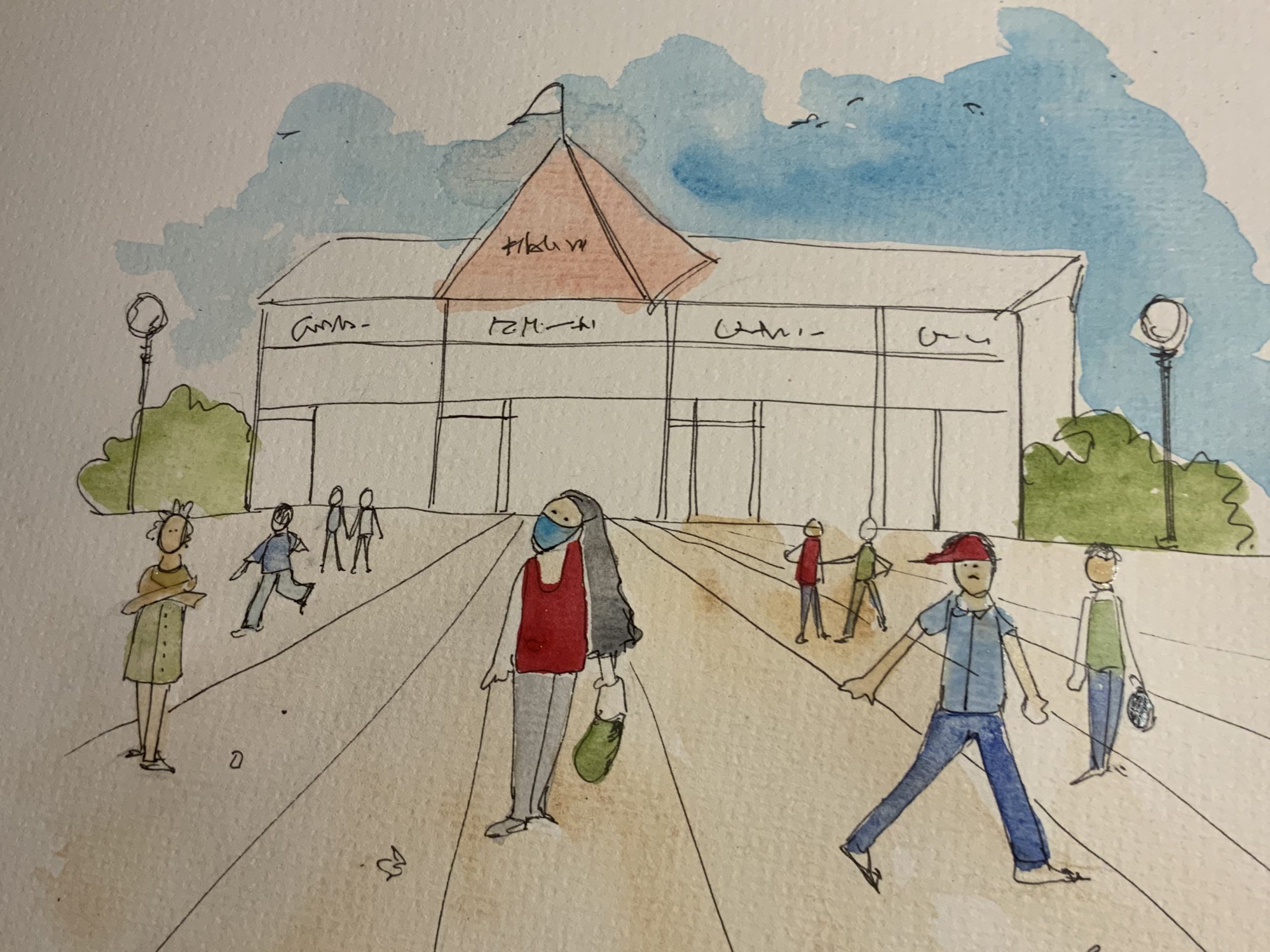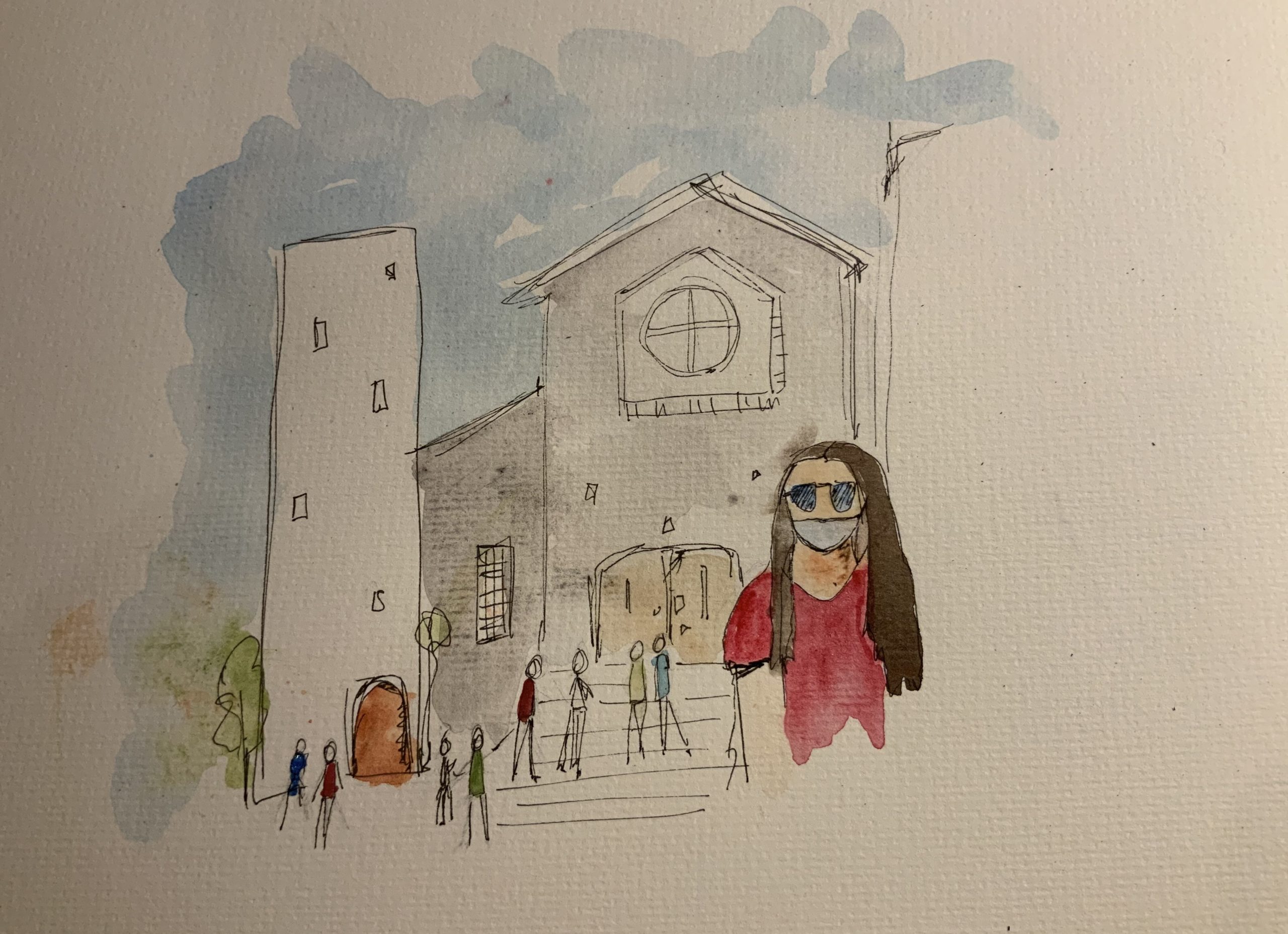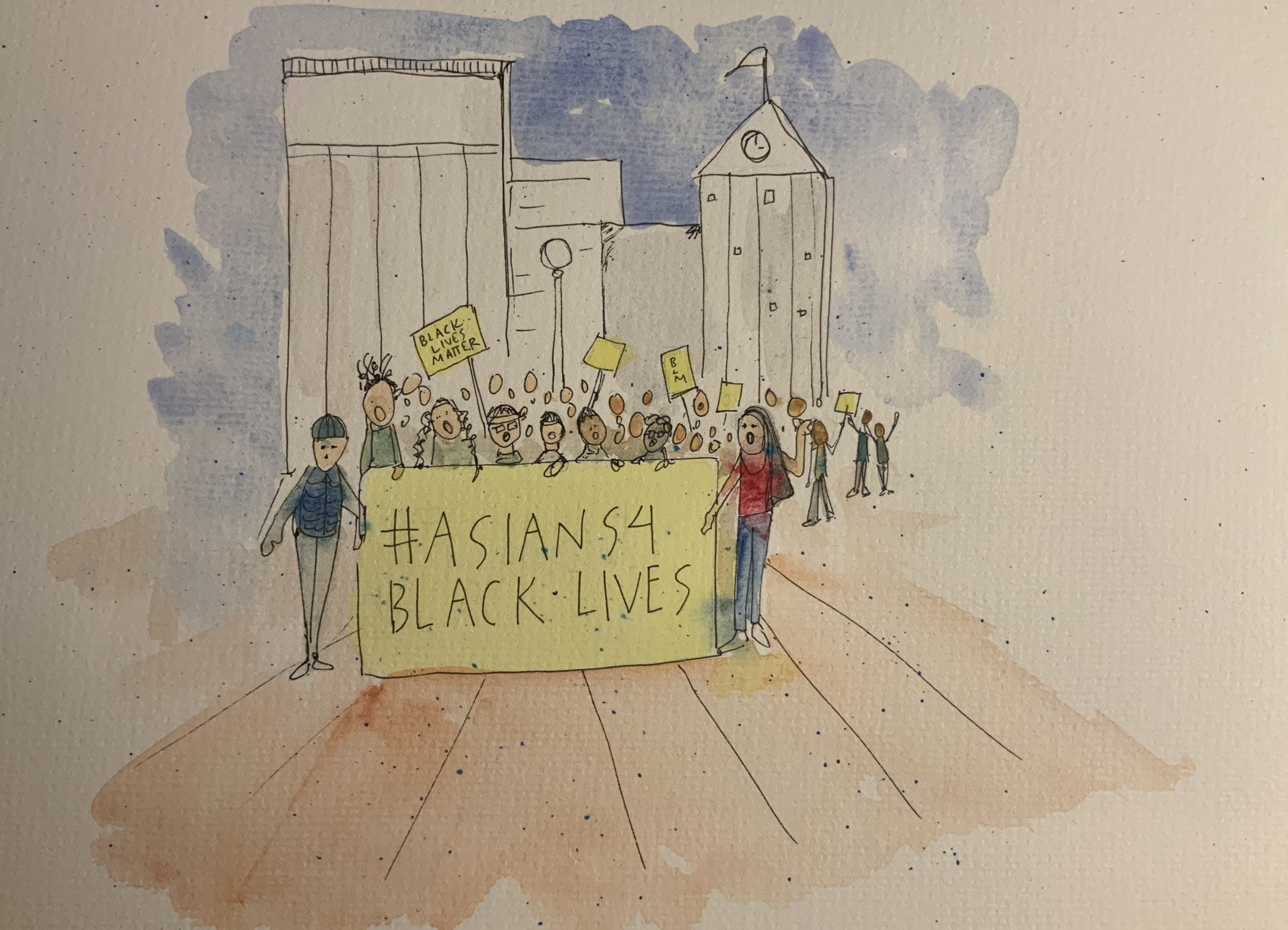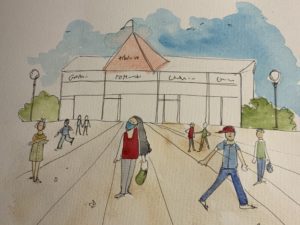
Entry
When the Chinese authorities order a complete lockdown of Wuhan’s eleven million residents, I’m at a Target in Austin, Texas, standing in an aisle lined with garish hearts and cupids. Valentine’s Day is looming, and I’m grateful for the distraction. The scenes circulating on social media are apocalyptic—shuttered stores, empty streets, hulking arcs of concrete highways with no cars. I walk the store with a sense of foreboding, trying to imagine millions of people in quarantine.
As I round the corner behind a group of people, I sneeze. Once, twice, then a third time. Spring has arrived unseasonably early, and with it, the dreaded cedar fever that is the bane of my city. I lift my face from my elbow to find that the aisle is now clear. All four people in front of me have flattened themselves against the shelves, their faces registering varying shades of trepidation and mild panic. I freeze. We eye each other in stunned silence.
One of them, an older man in a Hawaiian shirt, speaks first. “Go ahead,” he says.
I smile awkwardly and squeeze by. No one says “bless you.” In fact, no one says anything. When they’re out of sight, I text my friend.
Think I just scared a bunch of white people for sneezing while Asian, I write.
LOL WHAT? comes the reply.
On the other hand, I do look pretty scary today. I add a laugh emoji and hit send.
I decide that I’m just imagining things. Here in Austin, the cadence of life thrums on as usual; nothing feels out of the ordinary. That night while my husband makes dinner, I watch video footage of a doctor in Wuhan. She is exhausted and traumatized from treating an onslaught of COVID-19 patients, screams in Mandarin that she can’t take it, claws at her throat while her colleagues witness her excruciating mental breakdown. I cross my fingers reflexively. Let’s hope it doesn’t come here, I think.
Incubation
By the end of February, the virus is spreading rapidly within the US, and the markets begin a startling free fall. The president—alarmed at last and only by an impending economic downturn—kicks into high gear, criticizing “the Democrat policy of open borders” for the rise in infections. No target is spared, from Chuck Schumer to the Obama administration, and I start feeling the deep pangs of a new anxiety. As a Chinese-Singaporean woman who is visibly East Asian, I know what’s coming next. I’m already noticing people going out of their way to cross the street when they see me; seemingly overnight, I’ve acquired the ability to part crowds. In the parking lot of a strip mall, an older man in an Astros baseball cap looks surprised to see me, grimacing and shaking his head as if I’ve snuck in under the barricades, as if to shame me for the subterfuge. My inner sixteen-year-old immigrant—the girl with the too-formal shoes, the off-brand clothing, the unplaceable accent—is back, this time with strange and terrifying powers. As a teen, I once harbored dreams of fame and adoration. Now, I’d give anything to be able to blend in.
I decide to try something new. I start greeting strangers with pleasantries—smiling and making eye contact. This feels utterly contrived for an introvert, but I keep at it, even when it makes me cringe. Anti-Asian violence is on the uptick, a thunderbolt slicing open urban areas and small towns alike. If we were fighting for visibility before, we now have it in spades, except it has arrived in the perverse form of spit, fists, fury. In the eyes of some, we’re worse than disease vectors: we are the disease.
To combat my spiking anxiety, I digitally unplug for a week, willfully lulling myself into somnambulant denial. Nothing bad will happen here; the media sensationalizes news; the good people of America know better.
Eventually, curiosity gets the better of me. I log on to Facebook and scroll backward to see what I’ve missed. The first post that catches my attention is about an Asian boy in the San Fernando Valley who is jumped at his middle school for supposedly carrying the virus. He suffers head injuries so severe that he needs to be rushed to the emergency room. His family, terrified of repercussions, has opted to stay silent. A separate post directly underneath features Trayvon Martin, commemorating what would have been his twenty-fifth birthday. The photo already looks dated, but his smile, his kind eyes, are frozen in time. I try to recall the names of all the Black children who have been killed since Trayvon’s death in 2012, but there are just too many to list. Therein lies the truth about the hungry maw that is America: while anti-Asian violence is deemed unusual and therefore newsworthy, the killing of Black people is so pedestrian, so commonplace as to form the de facto backdrop of our collective consciousness.
Replication
On March 17, I awaken to a tweet from the president referring to COVID-19 as a “Chinese virus.” It takes all my willpower not to fling my phone across the room. I’ve known—based on the botched federal response, based on the coded racism of media reports about “wet markets” and “bat eating”—that this was coming. What better way for an administration to purge itself of culpability than by highlighting the virus’s foreign origins? What greater foil for wholesome Americana than the shifty Chinese, with our questionable tastes and strange culinary traditions? In this new lexicon amplified by the president, I am no longer a human being: I am the spiked parasitic molecule; I am the amorphous membrane brimming with pestilence. The words embody a horrifying efficiency, a singular power to strip me down to something vile and unrecognizable. A day after the “Chinese virus” tweet, during a White House briefing, the president repeatedly defends the use of the term. He shrugs, turns his palms skyward. In that moment, I understand that my security in this country is now a coin toss—untethered, inconsequential, subject to the casual deliberations of an unabashed racist.
Later, I order lunch tacos with a fifth-generation Texan who fancies himself a cowboy. He tells me how he uses night-vision goggles to hunt feral hogs in the dark. Listening to him is like stepping into the predatory mind, like peering through the scope of his LaRue AR-15. This is useful information. Since hunting season has been declared on Asians, I decide that what I need are protective goggles of my own. I reach into my purse, find my sunglasses, and slip them on. I start wearing them whenever I venture outside, even on cloudy days. By hiding my East Asian features, the world feels safer, more benign, yet I’m wracked with grotesque self-loathing. When the murders of Ahmaud Arbery, Breonna Taylor, and Elijah McClain start circulating on social-media, I am reminded, on a bone-deep level, that my privilege of invisibility within white America simply does not exist for Black Americans.
After our mayor announces a shelter in place order for Austin, I head to the grocery store. Tensions are running high, aisles crammed with people who are panic-buying toilet paper and pasta sauce. In the toiletries aisle, a toddler lumbers unsteadily toward me. I smile and wave at him. Before he gets near, his mother—a white woman—swoops down to pick him up. She jimmies him into her cart and swivels away, but not before shooting me a look of contempt. Her mask of disgust and revulsion reminds me of a recent news story involving a Burmese family in Midland, Texas. Jose Gomez, nineteen, stabbed a father, mother, and their two children at Sam’s Club while they were out on a shopping errand. The kids, aged two and six, survive the attack, but one of them has a cut reaching from behind his ear, all the way across to his eye. The other sustains a wound to his lower back. According to FBI reports, Gomez stabbed them on suspicion of carrying COVID-19. I picture this family as I push my cart into another aisle, heart pounding, willing myself to finish shopping. After loading the bags in my car, I catch a glimpse of myself in the mirror. My cheeks are flushed, my eyes wild. I tell myself: you didn’t get knifed; you got lucky this time.
I decide that “at least” is no longer enough, camouflage is no longer enough. The loathing etched into the mother’s face is a sea-change, a harbinger of things to come. If the stabbing in Midland occurred at a grocery store in broad daylight, it’s clear that I need more protection. Three days later, an Amazon package containing pepper spray arrives on my doorstep. I still don’t plan on owning a gun, but here’s how I move through America now: with one hand curled tight around a cold metal shaft, trigger finger poised and at the ready.
Outbreak
The truth, like the virus, is a hydra-head. Before we were the “Chinese Virus”, Asian Americans were nerds, math heads, the model minority. We were coolies, prostitutes, the Sick Man of the East. We were kung fu masters and job thieves, dragon ladies and war traitors, America’s fever dream and opaque mystery. Dominant culture has painted us as many things: usually caricatures, not quite human, and never fully American. Asians have seesawed through American history as the hardworking émigrés du jour during acute labor shortages, only to be redesignated as opium-smoking Chinese degenerates during the Gold Rush, or as enemies of the state in the era of Japanese internment camps. It should come as no surprise that in the age of COVID-19, the Trump administration simply reshuffled the deck, yanked our immigrant darling card, and replaced it with The New Yellow Peril.
As things stand, there are two viruses ripping through our lands. Only one of them can be alleviated by insularity and social distancing. The other illness, racism, is as old as the country itself. In a Washington Post op-ed, former presidential candidate Andrew Yang called for Asian Americans to combat the rising violence by “showing our American-ness” and wrapping ourselves in the red, white, and blue. While well-intentioned, the crux of his argument implies that humanity is a commodity to be earned and duly bequeathed by its rightful owners. The trouble with this approach is that it attaches conditions to humanity where there are none. In order to be treated like a human being, one only needs to be human. Period. Even worse, it reduces Asian Americans to despairing supplicants while absolving racists of any accountability. In Yang’s Asian America, the burden is placed on an already othered community—one that has never been seen as fully American.
This instinct to blend in, assimilate, flatten ourselves, disappear is the unfortunate result of an old colonialist tradition of waging wedge politics between Black Americans and Asian Americans. By deploying the model minority label, the political establishment dangles white adjacency as a carrot to Asian Americans while also using Asian American gains as a cudgel to shame the Black community. This strategy is repugnant in light of the fact that, unlike the Black community, Asian Americans were spared the full brutality of slavery, public lynchings, Jim Crow, redlining, and mass incarceration. Without Black activists laying the crucial groundwork for the Civil Rights Act of 1964 and the Voting Rights Act of 1965, it is unlikely that the Immigration and Nationality Act would have followed. This landmark piece of legislation was singularly responsible for a groundswell in Asian immigration to the United States. Today’s anguished calls for Black justice, ringing raw in throats all over America, must be heard and acknowledged as a rallying cry from a community to whom Asian Americans owe an immeasurable debt. In forging this solidarity, we follow in the footsteps of Asian American activists like Grace Lee Boggs, Yuri Kochiyama, and Richard Aoki, who aligned with and fought ceaselessly on behalf of Black liberation during the civil rights era. It is through us that this proud tradition can, and must, continue.
The time has come for Asian Americans to cement their foothold. To achieve this, there are several viable paths forward, all of which must include Asian Americans embracing a more prismatic view of how white supremacy, capitalism, and state-sanctioned violence are insidious and intertwined. This looks like sitting with the painful acknowledgment that while the knee on George Floyd’s neck was white, the officer who protected and enabled him was Asian American. This looks like rejecting conscription into white supremacy by renouncing the model minority designation because it’s obvious that any security it provided was purely illusory. This looks like centering, supporting, and taking on Black struggles as our own. It is the exact opposite of disappearing into the model minority myth; it is to stand up, shoulder to shoulder, in genuine and full-throated solidarity. As we speak, this hard and humbling work has already begun. Privately and in the streets, Asian American groups have raised fists and funds in support of dismantling anti-Blackness and white supremacy. There is a new awakening, however fledgling, that Asian America’s struggles can no longer be decoupled with the protection and liberation of Black bodies.
In time, scientists may find a vaccine for COVID-19, and some aspects of our old lives may return. But the other disease is just as deadly, and equally essential to treat. Racism has killed us for longer, gutted our souls, cannibalized our collective spirit. We contain the first by distancing when we can. For the other, we, all of us, must dive into the fray. Into the struggle. Into the revolution that awaits.
***
Rumpus original art by Susan Ito.

